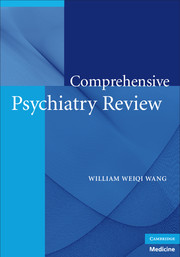Book contents
- Frontmatter
- Contents
- Introduction
- PART I INTELLECTUAL FOUNDATION OF PSYCHIATRY
- PART II EVALUATION AND MEASUREMENT
- 6 Evaluation of Signs and Symptoms
- 7 Classification and Diagnosis
- 8 Psychometrics
- 9 Biostatistics
- PART III PSYCHIATRIC DISORDERS
- PART IV PSYCHIATRIC THERAPEUTICS
- PART V NEUROPSYCHIATRY AND RELEVANT NEUROLOGIC CONDITIONS
- PART VI SPECIAL TOPICS
- PART VII REVIEW QUESTIONS
- Bibliography
- Index
6 - Evaluation of Signs and Symptoms
from PART II - EVALUATION AND MEASUREMENT
Published online by Cambridge University Press: 18 January 2010
- Frontmatter
- Contents
- Introduction
- PART I INTELLECTUAL FOUNDATION OF PSYCHIATRY
- PART II EVALUATION AND MEASUREMENT
- 6 Evaluation of Signs and Symptoms
- 7 Classification and Diagnosis
- 8 Psychometrics
- 9 Biostatistics
- PART III PSYCHIATRIC DISORDERS
- PART IV PSYCHIATRIC THERAPEUTICS
- PART V NEUROPSYCHIATRY AND RELEVANT NEUROLOGIC CONDITIONS
- PART VI SPECIAL TOPICS
- PART VII REVIEW QUESTIONS
- Bibliography
- Index
Summary
The language of psychiatry has evolved through the past century into a more precise and intuitive professional lexicon. The ability to precisely describe mental phenomena is a vital skill in clinical practice. Some of the terms may still carry the scent of old time when little scientific evidence was available; however, maintain in active use in accordance with the traditional communication in the profession.
Abulia
▶ Lack of impulse and motivation to act or think spontaneously
▶ Lack of ability to make decisions
▶ Indifference
Acrophobia
▶ Dread of high places
▶ Also known as “high anxiety”?
Affect vs. mood
▶ Both are descriptions of emotional status
▶ Affect is the observed outward manifestation
▶ Mood is the subjective inward feeling
Agnosia
▶ Loss of ability to recognize or interpret the significance of sensory stimuli
Agraphia
▶ Loss of ability to write
Akathisia
▶ Subjective feeling of motor restlessness
▶ Feeling the constant need of frequently moving or changing position
Akinesia
▶ Significant decrease or lack of physical movement
Alexithymia
▶ Inability to be aware of or to express one's own mood and feeling
Amaurosis fugax
▶ Transient monocular visual loss
▶ Causes
▶ Compromised internal carotid or ophthalmic artery (most common)
▶ Optic neuropathies
▶ Giant cell arteritis
▶ Angle-closure glaucoma
▶ Migraine
▶ Psychogenic – conversion
Anhedonia
▶ Loss of interest in almost any activity; often seen in depression
Anomia
▶ Loss of ability to tell names of objects
Anosognosia
▶ Loss of ability to recognize physical deficits
- Type
- Chapter
- Information
- Comprehensive Psychiatry Review , pp. 47 - 53Publisher: Cambridge University PressPrint publication year: 2009



